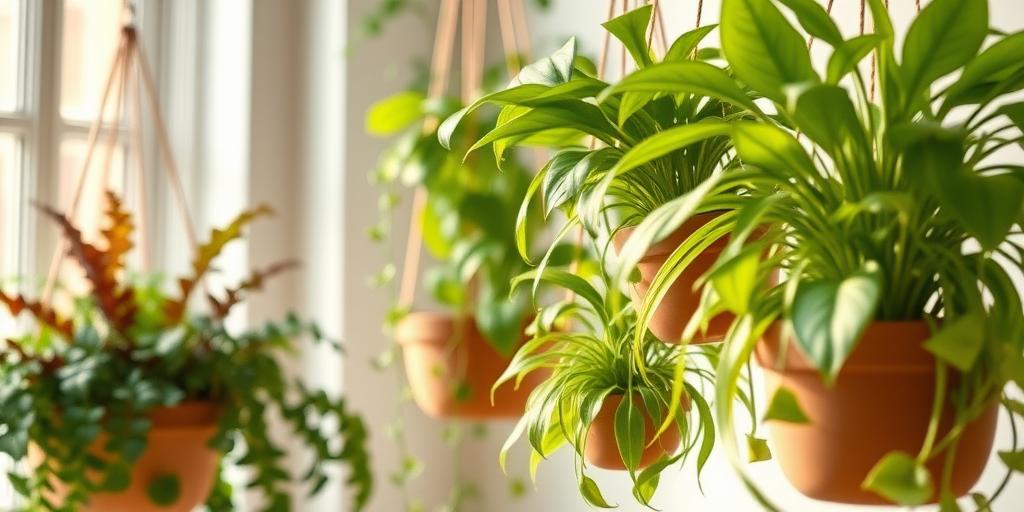
Maximize Your Space: Hanging Plants for Small Spaces
Discover the best hanging plants for small spaces to maximize your greenery without sacrificing floor space! Learn care tips, creative ideas, and stylish solutions for compact living.
Introduction
Living in a small space doesn’t mean you have to give up on lush greenery! Hanging plants are the perfect solution—they add life, purify the air, and elevate your decor without cluttering your floors. Did you know that indoor plants can reduce stress by up to 30%? Whether you’re in a cozy apartment or a tiny home, this guide will help you choose the best hanging plants, care for them effortlessly, and style them like a pro. Let’s turn your small space into a green oasis!
Why Choose Hanging Plants for Small Spaces?
Saves Valuable Floor and Surface Space
One of the biggest challenges in small spaces is making the most of every inch. Hanging plants eliminate the need for bulky plant stands or side tables, freeing up precious floor and surface space. Whether you live in a tiny apartment or a cozy studio, suspending your greenery from above keeps your living area open and uncluttered.
Enhances Vertical Decor and Adds Visual Interest
Walls and ceilings are often underutilized in small homes. Hanging plants draw the eye upward, creating a sense of height and dimension. A well-placed trailing vine or cascading fern can transform a blank wall into a living art piece, making your space feel more dynamic and intentional.
Improves Air Quality and Reduces Stress
Plants naturally purify the air by absorbing toxins and releasing oxygen. In compact living areas, where ventilation might be limited, this is especially beneficial. Plus, studies show that being around greenery can lower stress levels and boost mood—something we all need in tight quarters!
Easy to Maintain and Rearrange
Unlike large potted plants, hanging varieties are simple to move around. Want to shift your decor for a fresh look? Just unhook and reposition. Many hanging plants also require less frequent watering than their floor-dwelling counterparts, making them ideal for busy lifestyles.
Best Hanging Plants for Small Spaces
Pothos – Low-Maintenance and Fast-Growing
Pothos is a beginner-friendly favorite for good reason. It thrives in low to bright indirect light and can survive occasional neglect. Its long, trailing vines add a lush, jungle-like feel, and you can easily propagate cuttings to expand your collection.
Spider Plant – Thrives in Indirect Light and Purifies Air
Spider plants are practically indestructible. They adapt well to various light conditions and are excellent at filtering indoor air pollutants. Their arching leaves and tiny “spiderettes” (baby plants) add playful texture to any space.
String of Pearls – Unique Trailing Succulent for Boho Vibes
If you love quirky, eye-catching plants, the string of pearls is a must. Its bead-like foliage spills beautifully from hanging planters, creating a whimsical, bohemian aesthetic. Just give it bright light and let the soil dry between waterings.
Philodendron Heartleaf – Adaptable and Pet-Friendly (With Caution)
This charming vine features heart-shaped leaves that trail elegantly. It’s forgiving of low light and irregular watering, though it’s mildly toxic to pets—so hang it out of reach if you have curious cats or dogs.
Ferns (Boston, Maidenhair) – Lush Foliage for Humid Spaces
Ferns bring a touch of woodland magic indoors. Boston ferns are hardy and great for beginners, while maidenhair ferns (though more finicky) offer delicate, lacy fronds. Both love humidity, making them perfect for bathrooms or kitchens.
Creative Hanging Plant Ideas
Macramé Hangers – Stylish and Space-Saving
Macramé plant hangers add a boho-chic vibe while keeping pots off surfaces. They come in endless designs, from simple knotted styles to intricate woven patterns, and work well in corners or near windows.
Wall-Mounted Planters – Perfect for Tight Corners
No floor space? No problem. Wall-mounted planters or shelves allow you to tuck greenery into narrow gaps, like beside a bookshelf or above a desk. Mix small trailing plants with air plants for a layered effect.
Tiered Hanging Systems – Maximize Vertical Space
For serious plant lovers, tiered hanging systems let you grow multiple plants in one spot. Think cascading pothos on top, a spider plant in the middle, and a string of pearls at the bottom—all in one stunning display.
Ceiling Hooks & Rails – Flexible Arrangements
Install ceiling hooks or rails to create a customizable “green curtain.” This works especially well over a window or along a bare wall. You can adjust heights and swap plants seasonally for a fresh look.
DIY Repurposed Containers – Mason Jars, Baskets, or Teacups
Get creative with unconventional planters! Upcycle mason jars, woven baskets, or vintage teacups for a personalized touch. Just ensure they have drainage (or use them as decorative covers for nursery pots).
Care Tips for Healthy Hanging Plants
Light Requirements – Match Plants to Your Home’s Natural Light
Not all plants need a sunny windowsill. Low-light lovers like pothos and philodendron can thrive in dimmer spots, while succulents (e.g., string of pearls) crave bright light. Observe your space’s light patterns before choosing plants.
Watering Schedule – Avoid Overwatering With Proper Drainage
Hanging plants dry out faster than ground-level ones, but overwatering is still a common killer. Always check soil moisture before watering—stick your finger an inch deep. Ensure pots have drainage holes to prevent root rot.
Pruning & Maintenance – Keep Plants Lush and Tidy
Regular trimming encourages bushier growth. Snip yellowing leaves or overlong vines to maintain shape. For trailing plants like spider plants, remove brown tips with clean scissors for a polished look.
Fertilizing – Use Gentle, Plant-Specific Nutrients
Feed hanging plants during their growing season (spring/summer) with a diluted liquid fertilizer. Succulents need a low-nitrogen mix, while foliage plants benefit from balanced formulas. Skip fertilizing in winter when growth slows.
Pest Control – Natural Remedies for Common Issues
Watch for pests like spider mites or mealybugs. Wipe leaves with neem oil or a mild soap solution to deter infestations. Isolate affected plants promptly to protect others.
Styling Hanging Plants in Small Spaces
Layer Plants at Different Heights – Creates Depth
Avoid a flat, one-note look by hanging plants at varying levels. Combine a high-mounted pothos with a mid-level fern and a low-hanging string of pearls for a dynamic, tiered effect.
Mix Textures & Colors – Adds Visual Appeal
Pair glossy philodendron leaves with the feathery fronds of a fern or the quirky beads of a string of pearls. Variegated plants (like certain pothos or spider plants) introduce subtle color without overwhelming a small room.
Use Mirrors to Reflect Greenery – Makes Spaces Feel Larger
Strategically place mirrors opposite or near hanging plants to amplify their presence. The reflection tricks the eye into perceiving more greenery and expands the sense of space.
Incorporate Shelves With Hanging Plants – Balanced Look
Blend hanging and shelf-displayed plants for harmony. For example, mount a shelf with small potted succulents and hang a trailing plant just below it. This balances vertical and horizontal elements.
Choose Minimalist Pots – Keeps Focus on the Plants
In tight quarters, overly decorative pots can feel busy. Opt for simple, neutral planters—think white ceramic, terracotta, or sleek black—to let the plants’ natural beauty shine.
Conclusion
Hanging plants are a game-changer for small spaces—bringing nature indoors without sacrificing style or functionality. From low-maintenance pothos to elegant string of pearls, there’s a perfect plant for every corner. With the right care and creative displays, you can transform even the tiniest space into a lush retreat. Ready to start? Pick your favorite hanging plants and let your greenery soar!
